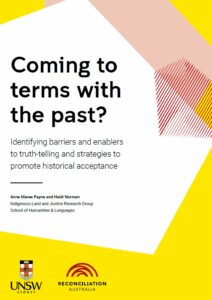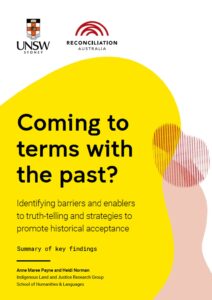Summary
Aboriginal and Torres Strait Islander people have tirelessly advocated for truth-telling as a crucial step on Australia’s path to recognition and reconciliation.
Despite this, there is a gap in existing research about what encourages Australians to engage with truth-telling and and our shared history.
The Coming to terms with the past? Identifying barriers and enablers to truth-telling and strategies to promote historical acceptance report steps into this space, aiming to advance our understanding of:
- what is truth-telling to Aboriginal and Torres Strait Islander peoples and non-Indigenous Australians
- the key barriers to and enablers of engagement with truth-telling and First Nations histories
- the implications of these findings for progressing truth-telling in community settings.
A collaborative study between Reconciliation Australia and UNSW’s Indigenous Land and Justice Research Group School of Humanities & Languages, the research sought answers through a literature review, media survey, online surveys and in-depth interviews.
Findings include important considerations for the planning and delivery of effective truth-telling initiatives; as well as uncovering what motivates First Nations and non-Indigenous people to get involved.
The full report provides an overview of all of the research’s findings. Read the full report.
The summary of the key findings compiles top-line implications from the research into a 6-page resource. Read the summary of key findings.
For further reading, please see in-depth reports on the sources that contributed to the research’s findings:





